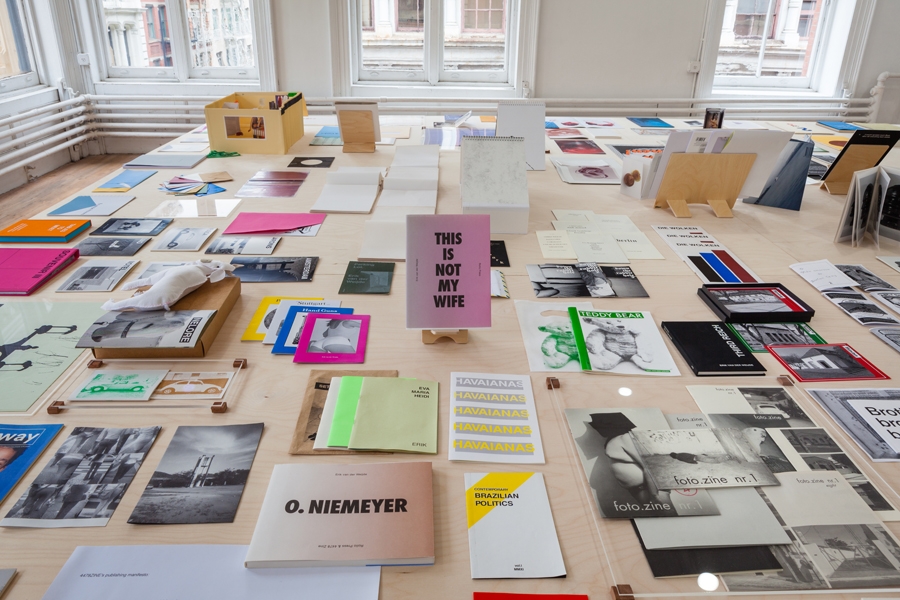During the late 1950s two gay artists began a strange project that infiltrated a local library in London. The figures in question were Joe Orton, subsequently a celebrated playwright, and his lover Kenneth Halliwell. The artists collaged their own pictures and texts onto existing book covers, creating new, imagined publications that promised surreal, subversive and homoerotic smut. The lovers were consequently prosecuted, spending six months in jail, and the episode is most often recounted as the founding incident in Orton’s public notoriety. However, in a recent exhibition at Artists Space, New York, the episode was reread as a curious case within the ongoing triangulation between art, the book and the library.
The exhibition was The Library Vaccine, an exploration of six distinct projects spread over the institution’s two spaces – including its Books & Talks annexe. These projects ranged chronologically from the time of Orton and Halliwell’s prank to the present day, and each consisted of a grouping of books, although these sets were formed according to a variety of organising principles. Some of the groupings took the form of a library – or addressed the principle of circulation – while others might more properly be called collections. Some were put together by artists, while others were assembled by curators or publishers. And some contained artist books, while others contained a much wider variety of texts.
One prominent theme in the exhibition was the relationship between the library and authority. This was implied in Orton and Halliwell’s attack on the institution of the library, but was also raised in two of the exhibition’s more recent projects, which presented personal libraries embodying antiauthoritarian logics. One belongs to the author Helen DeWitt, who displayed her own library, arguing for it as an open presentation of her writing practice. A second was that of Colin de Land – the impresario behind American Fine Arts, who died in 2003 – which has been kept together by a collector and made available for exhibition, its eccentric contents continuing to act as an index of the freewheeling approach that this influential New York gallerist took to art and its institutions.
Another question raised by the exhibition is how artist books – as a distinct category – might relate to this principle of collection and circulation
Another question raised by the exhibition is how artist books – as a distinct category – might relate to this principle of collection and circulation. The exhibition took its title from curator and writer Edit deAk, who, in a 1981 text, spoke of artist books as ‘the library vaccine, a healing agent formed from the very disease they cure’. This text also reflects the library’s role as a symbol of authority, as well as the powerful idea, originating during the 1960s, of artist books as an alternative or utopian form of publishing – a phenomenon that was figured in the exhibition by a re-presentation of Vigilance, a project curated by Mike Glier and Lucy Lippard in New York in 1979.
As the poster for Vigilance announced: ‘Although it is far from living up to its populist potential, the artist’s book can be produced in great numbers and distributed internationally. Even though it has volume, it is intimate much like a letter, and, like a letter, it invites dialogue between the sender and receiver. The artist’s book is a successful democratic form looking for compatible subject matter.’ The Library Vaccine gathered many of the publications that had featured in the original exhibition, including artist projects touching on a wide range of social and political issues, and featuring books such as Rape Is (1972/76) by Suzanne Lacy.
Vigilance stood as a magnetic pole within the exhibition, as the most activist interpretation of the relation between art, the book and the ‘corpus’. However, The Library Vaccine also described a countertendency, whereby, as the curators argued, these political aspirations have been gradually subsumed ‘within broader tendencies towards collecting, archiving and the re-circulation of knowledge’. The exhibition’s presentation of projects with such a wide range of organising principles – it also contained a selection of books produced over many decades by the artist-turned-publisher Hansjörg Mayer, and a collection of recent artist books assembled by the curator Gregorio Magnani – emerges as an attempt to construct a partial history of this larger cultural process.
Do we agree, as the curators of this exhibition suggest, that the activist paradigm in our culture has been gradually replaced by the archivist one? It’s a depressing thought – and the exhibition could have expanded more on its argument – but there is surely a broad truth in it. This interpretation certainly chimes with the dominance of the collating function within our own digital lives, the lead example being our relation to social media. However, The Library Vaccine also demonstrates how flexible the logic of archiving and recirculating can be, its ability to register personal, social and artistic nuance. These highly divergent collections show how artists and others have been able to use and abuse the form of the library to make – in Helen DeWitt’s phrase – their own social machines.
This article was first published in the December 2014 issue.
